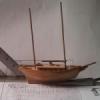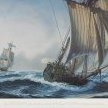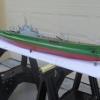-
Posts
8,764 -
Joined
Reputation Activity
-
 cog got a reaction from popeye the sailor in Bismarck by Semorebutts - FINISHED - Trumpeter - 1/200 scale - PLASTIC - with MK1 detail set
cog got a reaction from popeye the sailor in Bismarck by Semorebutts - FINISHED - Trumpeter - 1/200 scale - PLASTIC - with MK1 detail set
What I do: I spray a layer of gloss lacquer, add the decals, when fixed, spray a layer of clear lacquer, satin or mat, and after that shade or weather or whatever
-
 cog got a reaction from popeye the sailor in Bismarck by Semorebutts - FINISHED - Trumpeter - 1/200 scale - PLASTIC - with MK1 detail set
cog got a reaction from popeye the sailor in Bismarck by Semorebutts - FINISHED - Trumpeter - 1/200 scale - PLASTIC - with MK1 detail set
Depends if the shading should pass over the decal or not. If it does it's easy, than it is "Yes", you'll be inventive enough for the other possibillity
-
 cog got a reaction from lmagna in Endeavour 1934 by Julie Mo - Amati - Scale 1:35 - America's Cup UK J-Class Challenger
cog got a reaction from lmagna in Endeavour 1934 by Julie Mo - Amati - Scale 1:35 - America's Cup UK J-Class Challenger
Another challenge for the Mo ... I would suggest to make a new piece ...
-
 cog reacted to RGL in Bismarck by Semorebutts - FINISHED - Trumpeter - 1/200 scale - PLASTIC - with MK1 detail set
cog reacted to RGL in Bismarck by Semorebutts - FINISHED - Trumpeter - 1/200 scale - PLASTIC - with MK1 detail set
I think what Cog said. I’m crap at planes. I just use decal fix.
-
 cog got a reaction from Canute in Bismarck by Semorebutts - FINISHED - Trumpeter - 1/200 scale - PLASTIC - with MK1 detail set
cog got a reaction from Canute in Bismarck by Semorebutts - FINISHED - Trumpeter - 1/200 scale - PLASTIC - with MK1 detail set
What I do: I spray a layer of gloss lacquer, add the decals, when fixed, spray a layer of clear lacquer, satin or mat, and after that shade or weather or whatever
-
 cog got a reaction from Piet in Black Pearl by Old Collingwood - FINISHED - 1/72 Scale
cog got a reaction from Piet in Black Pearl by Old Collingwood - FINISHED - 1/72 Scale
I would say: "Hang in there mate" you've got still some yards to go ... looking good
-
 cog got a reaction from Canute in Bismarck by Semorebutts - FINISHED - Trumpeter - 1/200 scale - PLASTIC - with MK1 detail set
cog got a reaction from Canute in Bismarck by Semorebutts - FINISHED - Trumpeter - 1/200 scale - PLASTIC - with MK1 detail set
Depends if the shading should pass over the decal or not. If it does it's easy, than it is "Yes", you'll be inventive enough for the other possibillity
-
 cog reacted to Old Collingwood in Black Pearl by Old Collingwood - FINISHED - 1/72 Scale
cog reacted to Old Collingwood in Black Pearl by Old Collingwood - FINISHED - 1/72 Scale
Indeed.
OC.
-
 cog reacted to dmalcolm72 in Black Pearl by Old Collingwood - FINISHED - 1/72 Scale
cog reacted to dmalcolm72 in Black Pearl by Old Collingwood - FINISHED - 1/72 Scale
"...some yards to go?" No pun intended there, eh? 🤔
-
 cog reacted to Dr PR in Albatros by Dr PR - FINISHED - Mantua - Scale 1:48 - Revenue Cutter kitbash about 1815
cog reacted to Dr PR in Albatros by Dr PR - FINISHED - Mantua - Scale 1:48 - Revenue Cutter kitbash about 1815
6 POUNDER CANNONS
The Mantua kit included six small cannons. At first I thought they were too small to be used on a revenue cutter, but I compared their length to information for various cannons used in the early 1800s and found they were approximately correct for 1:48 scale 6 pounders. 6 pounder guns were used on the revenue cutters, so I decided to make carriages for them and see how they worked on the 1:48 model.
This image shows the 12 pounder cannon used on the pivot gun at the top. The 6 pounder cannon is below it. Actually, both guns are a bit "pudgy" or broader in proportion to length for the dimensions of the real cannons of the period. But I decided to use them on this build anyway.
The next picture shows a major problem with the cannons supplied with the kit. Both barrels were bored out to ridiculous diameters. The walls were so thin that the cannons would have exploded if they were fired with enough charge to expel the ball from the muzzle! Comparing length to bore diameter the 12 pounder was bored for a 28 pound ball, and the 6 pounder was bored for a 24 pound shot!!
I soldered concentric brass tubing into the barrels and then bored the barrels to the proper diameters. The 12 pounder fired 4.5 inch balls, and the 6 pounder fired 3.75 inch balls. The photo shows the original over sized bore and the resulting correct bore dimensions.
Another problem with the parts supplied with the kit was the height of the barrels on the 6 pounders when mounted on the supplied carriages and wheels. The barrel height was about the same as the top of the railing on the bulwarks. This meant the guns could only be aimed downward! That's OK if you are using them for fishing, but they would have been useless for any other purpose.
The drawing shows the plan for gun carriages that would work on the model. The ship had substantial camber to the deck, so when the ship was on an even keel the deck edge sloped downward. To get the guns to fire with just slight elevation the carriages would have to be significantly lower than the kit parts, and the rear wheels would have to be much smaller diameter than the front wheels (this was common on real gun carriages). Using the dimensions of the deck, bulwark and rail on the model and the kit supplied cannons I worked out the dimensions of the carriages and wheels to allow the guns to be run out with the barrels horizontal (solid red outline) and to be fired with up to 5 degree elevation (dashed blue outline) with the quoin removed. However, if they were fired with elevation the recoil back up the sloping deck would have caused the top of the barrel to strike the railing over the gun port. The red dashed line shows the travel path of the top of the barrel in the horizontal position - it just clears the rail.
I constructed new carriages for the 6 pounders. Each carriage had seven wooden parts, four brass wheels, a pin head for the quoin handle and two metal loops for the gun tackle. To put things in scale, the small brass wheels are 0.125 inch diameter. It was a lot of small parts to make. Just imagine doing this for a 100 gun ship of the line!
I thought I might make the wheels from wood, but 1/8 inch dowels were not suitable for boring the 1/16 inch diameter holes for the axles. I used concentric brass tubing soldered together, two layers for the small wheels and four layers for the large (3/16 inch diameter) wheels. I chose this route because I do not have a lathe to drill the 1/16 inch holes into brass rods.
Here are pictures of the kit supplied carriages (left) and the scratch built carriages (right). As you can see, the scratch built carriages mount the guns lower. In addition, they are much more correct in the details. The axles are even drilled to allow pins to be inserted to secure the wheels.
Here is the full 6 pounder battery.
-
 cog reacted to michael mott in Skipjack by michael mott - 1/8th scale - SMALL - 19 foot open launch
cog reacted to michael mott in Skipjack by michael mott - 1/8th scale - SMALL - 19 foot open launch
All the parts ready to solder, I had to shave the opening with the knife blade as if I was de burring to shape the hole to cause the lens holder to angle down
Soldered with regular soft solder
A new former to form the curved top was made from maple
forced into some soft Jelutong
it was ok but I wanted a crisper form so trued soe soft end grain maple
it didn'r work and destroyed the form
I made a new form out of brass and set it on a 5/16 rod with some locktite
out of sequence picture of the raw block
shaped and polished with a stub of 5/16 in filled in the hole, I did not use the short stub and made a longer one.
A new block from some linden salvaged from an old drafting board a few years ago.
a couple of tries with the new block and form with some anealed .005"
A couple of presses later the form is deep enough.
Filing off the excess with a safe edged file
The journey so far, in this last picture the lamp is upside down, but i am pleased with the curved top.
and a decent opening for the door.
Michael
-
 cog reacted to michael mott in Skipjack by michael mott - 1/8th scale - SMALL - 19 foot open launch
cog reacted to michael mott in Skipjack by michael mott - 1/8th scale - SMALL - 19 foot open launch
Thanks for all the kind remarks.
Well like many of the other things that I have made over time on these models. Now that I know what I am up against I started over with some thicker brass sheet and laid it out differently.
glued to block with double sided tape and drilled.
cut out with jewelers saw
Using the original for block.
The second bend required an extra spacer
Next a small tab on the back side needed to be folded for soldering the shell together
Ready to fold the tab
+
closing the back require a different strategy so out came the long needle nosed pliers and the back was gently eased over with a flat block
floding down the tab to match the back
After some twaeking with the needle nose it all sat pretty nicely.
Will continue in the next post
Michael
-
 cog reacted to KORTES in SPERWER by KORTES - FINISHED - 1:30 scale - Friescheboeier Yacht
cog reacted to KORTES in SPERWER by KORTES - FINISHED - 1:30 scale - Friescheboeier Yacht
I assembled and installed zwaard.
-
 cog got a reaction from Piet in Black Pearl by Old Collingwood - FINISHED - 1/72 Scale
cog got a reaction from Piet in Black Pearl by Old Collingwood - FINISHED - 1/72 Scale
How did you know ... straight forward as always ...
-
 cog got a reaction from Canute in Black Pearl by Old Collingwood - FINISHED - 1/72 Scale
cog got a reaction from Canute in Black Pearl by Old Collingwood - FINISHED - 1/72 Scale
I would say: "Hang in there mate" you've got still some yards to go ... looking good
-
 cog got a reaction from CaptainSteve in La Créole 1827 by archjofo - Scale 1/48 - French corvette
cog got a reaction from CaptainSteve in La Créole 1827 by archjofo - Scale 1/48 - French corvette
beautiful work Johann. It shows you took the time to prepare!
-
 cog got a reaction from Piet in SMS Seydlitz by Canute, Cog, Stein Gildberg & RGL - FINISHED - Hobbyboss - 1/350 - PLASTIC
cog got a reaction from Piet in SMS Seydlitz by Canute, Cog, Stein Gildberg & RGL - FINISHED - Hobbyboss - 1/350 - PLASTIC
You've got my work cut out for me ... Great result
-
 cog got a reaction from mtaylor in Black Pearl by Old Collingwood - FINISHED - 1/72 Scale
cog got a reaction from mtaylor in Black Pearl by Old Collingwood - FINISHED - 1/72 Scale
I would say: "Hang in there mate" you've got still some yards to go ... looking good
-
 cog got a reaction from popeye the sailor in Bismarck by Semorebutts - FINISHED - Trumpeter - 1/200 scale - PLASTIC - with MK1 detail set
cog got a reaction from popeye the sailor in Bismarck by Semorebutts - FINISHED - Trumpeter - 1/200 scale - PLASTIC - with MK1 detail set
'arry,
What's a few pounds more or more ... fortunately I couldn't buy it as I'm unable to carry it presently ... you need to build a shed around it
-
 cog got a reaction from Louie da fly in SMS Seydlitz by Canute, Cog, Stein Gildberg & RGL - FINISHED - Hobbyboss - 1/350 - PLASTIC
cog got a reaction from Louie da fly in SMS Seydlitz by Canute, Cog, Stein Gildberg & RGL - FINISHED - Hobbyboss - 1/350 - PLASTIC
You've got my work cut out for me ... Great result
-
 cog got a reaction from Julie Mo in Endeavour 1934 by Julie Mo - Amati - Scale 1:35 - America's Cup UK J-Class Challenger
cog got a reaction from Julie Mo in Endeavour 1934 by Julie Mo - Amati - Scale 1:35 - America's Cup UK J-Class Challenger
Another challenge for the Mo ... I would suggest to make a new piece ...
-
 cog reacted to G.L. in Fishing Smack c. 1920 by G.L. - FINISHED - Scale 1/20 - POF - cross-section
cog reacted to G.L. in Fishing Smack c. 1920 by G.L. - FINISHED - Scale 1/20 - POF - cross-section
Well Michael, Now you bring me some embarrassment. My soldering station is not a technical masterpiece, but it is a self fabricated apparatus.
When I started to make ship models, I did not succeed in soldering well. Some years ago we had a demonstration in our modeling club about resistance soldering and seeing that, I had my eureka moment. That was the soldering method that I needed! The fellow who demonstrated had a commercial built soldering station that was quite expensive and it was not available for purchase in Belgium but he said that it could be built relatively easy by yourself. So I started to search on the internet. My technical English is not sufficient to explain the resistance soldering technique in an intelligent way so I refer to this website for more information: Resistance soldering
To build my station, I used following diagrams (source: Cooltrain.be):
For a techno-illiterate like me even the above diagram is a mystery, so I used the scheme for dummies (source: Cooltrain.be) below:
It gave me the necessary information to buy and search all the needed components and to fabricate my soldering station.
That is like it looks inside.
Now I am able to solder as well. But I am still far from making a navigation light like you are doing for your skipjack.
The main advantage of resistance soldering is that there is a intense heat produced in a fraction of time at the carbon point of the soldering pin. It allows to solder in the close vicinity of other soldered parts without melting those other parts loose.
-
 cog reacted to semorebutts in Bismarck by Semorebutts - FINISHED - Trumpeter - 1/200 scale - PLASTIC - with MK1 detail set
cog reacted to semorebutts in Bismarck by Semorebutts - FINISHED - Trumpeter - 1/200 scale - PLASTIC - with MK1 detail set
I started today by masking off Mr. arado.
then i airbrushed model air “black green” I then pulled off the masking tape and hoped for the best.
well thats acceptable. Time to brush the engine black.
next I placed the canopy in postion and added tiny drops of glue all the wAy around it.
i then brushed light sea grey onto the struts.
last I added the prop.
i just have the decals to do now I think.
-
 cog reacted to mtaylor in Black Pearl by Old Collingwood - FINISHED - 1/72 Scale
cog reacted to mtaylor in Black Pearl by Old Collingwood - FINISHED - 1/72 Scale
By jove, I think you've got it. Looking good on the shrouds.
-
 cog reacted to Old Collingwood in Black Pearl by Old Collingwood - FINISHED - 1/72 Scale
cog reacted to Old Collingwood in Black Pearl by Old Collingwood - FINISHED - 1/72 Scale
Evening all - thank you for all the likes and comments, as we all know its the inspiration that motivates all of us, anyway I worked on my first shroud rope assembly - first I made a device for holding the right gap between deadeyes, for this I used some thick fuse wire - when I set the gap I wanted I ran the shroud rope down and round the bottom of the deadeye - holding the return of the rope taut, I added a few drops of ca the applied a bit more to the top of the deadeye - and pushed both ropes together to close the gap where the return of the rope was.
I then tied a knot using fine black thread then round a few runs and glued over the fine thread, so first shroud with a deadeye attached and lashed.
This was repeated on the other side - then it was the turn to lace the channel deadeyes to the shrouds, first I de-fuzed the thread using some watery pva that I just ran along a length of thread between my fingers - this smoothed the thread and made it slightly easier to pass through the eyes, so I did a few dry attempts but discovered I had to lace it a slightly different way starting from the shroud deadeye and not the channel one - all this means is finishing at a lower hole to run the thread up to lash and glue around the shroud/deadeye link.
So I managed to do the very first one both sides inluding trimming the finished ends.
Here are a few pics (if they load that is)










